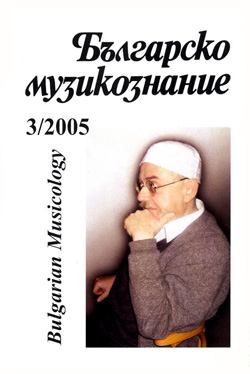Ориенталски образи и орбити в записана музика от България през първата половина на XX век
Oriental Images and Orbits in Music Recorded in Bulgaria During the First Half of the 20th Century
Author(s): Ventcislav DimovSubject(s): Music
Published by: Институт за изследване на изкуствата, Българска академия на науките
Summary/Abstract: Introduction: on the common trajectories of orientalism in recorded music The object of this text is not the oriental music but some Bulgarian images of the Orient. The field of research is the music recorded in Bulgaria during the first half of the 2ou1 century and some additional information that goes with it: gramophone records, catalogs and discographies, articles about that music printed by the press or some specialized periodicals, archive materials about the musical past. The theoretical approaches on the topic are centered on researches on the identity, the imaginary communities, the recreated traditions, the nationalism, the stereotyping. Key points are the researches of Eduard Said on orientalism and those of Maria Todorova on balkanism. The orientalised examples of recorded Bulgarian music give us a fair reason to regard them both as a part of the European musical orientalism and as specific Balkan variations of orientalism. The common thing between the above two things are that they are a way of rethinking the Eastern music in ways that are foreign for the places of its origin: its discursive depth is changed to external images; it is separated from its ethos and turned into an exotic sound impression and spectacle. Orientalism in the recorded Bulgarian music is predominant in its popular layers. Many of the popular tunes which were recorded on gramophone records and became popular in Bulgaria during the 1930s and the 1940s were related with operettas, popular at the scenes in Sofia at that time. The Bulgarian popular tunes with oriental stylistics are a local idiom of the European fashion in the operetta genre. The oriental in the recorded Bulgarian music according to the labels According to the labels on gramophone records, catalogs of publishers and distributors, to collections of song lyrics of gramophone-plate distributed songs, to radio programmes, the Bulgarian music that was recorded during the first half of the XX century is grouped into two basic types called folk music/folk songs and dance music/popular music tunes. The oriental theme as an etiquette and text information is present mainly in the dance music and the popular tunes. It is a dominant in the notation of local variations of the modem genres: the oriental tango, the oriental foxtrot; oriental slov. Some of the popular songs that were recorded by Bulgarian performers and companies, and had oriental etiquettes were creations of Bulgarian authors.. Musical images of the oriental The observations on the oriental in etiquettes of recorded music outline a rich repertoire. Besides the naming, the oriental motives are represented also as musical images. There are repeating patterns, which can be accepted as musical images of the oriental. Such a pattern in the melody is a augmented second. In the rhythm, the images of the oriental are related to the rhythmical schemes of dance melodies popular in Turkey and Greece: Ciftetelli -214 and Karsilama in the irregular r
Journal: Българско музикознание
- Issue Year: 2005
- Issue No: 3
- Page Range: 121-135
- Page Count: 15
- Language: Bulgarian
- Content File-PDF

